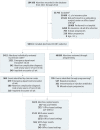Association of Facility Type With Procedural-Related Morbidities and Adverse Events Among Patients Undergoing Induced Abortions
- PMID: 29946727
- PMCID: PMC6583042
- DOI: 10.1001/jama.2018.7675
Association of Facility Type With Procedural-Related Morbidities and Adverse Events Among Patients Undergoing Induced Abortions
Erratum in
-
Data Error.JAMA. 2018 Jul 24;320(4):409. doi: 10.1001/jama.2018.9744. JAMA. 2018. PMID: 30043040 Free PMC article. No abstract available.
Abstract
Importance: Multiple states have laws requiring abortion facilities to meet ambulatory surgery center (ASC) standards. There is limited evidence regarding abortion-related morbidities and adverse events following abortions performed at ASCs vs office-based settings.
Objective: To compare abortion-related morbidities and adverse events at ASCs vs office-based settings.
Design, setting, and participants: Retrospective cohort study of women with US private health insurance who underwent induced abortions in an ASC or office-based setting (January 1, 2011-December 31, 2014). Outcomes were abstracted from a large national private insurance claims database during the 6 weeks following the abortion (date of final follow-up, February 11, 2015).
Exposures: Facility type for abortion (ASCs vs office-based settings, including facilities such as abortion clinics, nonspecialized clinics, and physician offices).
Main outcomes and measures: The primary outcome was any abortion-related morbidity or adverse event (such as retained products of conception, abortion-related infection, hemorrhage, and uterine perforation) within 6 weeks after an abortion. Two secondary outcomes, both subsets of the primary outcome, were major abortion-related morbidities and adverse events (such as hemorrhages treated with a transfusion, missed ectopic pregnancies treated with surgery, and abortion-related infections that resulted in an overnight hospital admission) and abortion-related infections.
Results: Among 49 287 women (mean age, 28 years [SD, 7.3]) who had 50 311 induced abortions, (23 891 [47%] first-trimester aspiration, 13 480 [27%] first-trimester medication, and 12 940 [26%] second trimester or later), 5660 abortions (11%) were performed in ASCs and 44 651 (89%) in office-based settings. Overall, 3.33% had an abortion-related morbidity or adverse event; 0.32% had a major abortion-related morbidity or adverse event; and 0.74% had an abortion-related infection. In adjusted analyses, there was no statistically significant difference between ASCs vs office-based settings, respectively, in the rates of abortion-related morbidities or adverse events (3.25% vs 3.33%, difference, -0.08%; [corrected] 95% CI, -0.58% to 0.43%; adjusted OR, 0.97; 95% CI, 0.81-1.17), major morbidities or adverse events (0.26% vs 0.33%; difference, -0.06%; 95% CI, -0.18% to 0.06%; adjusted OR, 0.78; 95% CI, 0.45-1.37), or infections (0.58% vs 0.77%; difference, -0.16%; 95% CI, -0.35% to 0.03%; adjusted OR, 0.75; 95% CI, 0.52-1.09).
Conclusions and relevance: Among women with private health insurance who had an induced abortion, performance of the abortion in an ambulatory surgical center compared with an office-based setting was not associated with a significant difference in abortion-related morbidities and adverse events. These findings, in addition to individual patient and individual facility factors, may inform decisions about the type of facility in which induced abortions are performed.
Conflict of interest statement
Figures

Comment in
-
Abortion-Related Adverse Events by Facility Type: Reassurance From a National Analysis.JAMA. 2018 Jun 26;319(24):2481-2483. doi: 10.1001/jama.2018.7906. JAMA. 2018. PMID: 29946708 No abstract available.
Similar articles
-
Healthcare costs for abortions performed in ambulatory surgery centers vs office-based settings.Am J Obstet Gynecol. 2020 Apr;222(4):348.e1-348.e9. doi: 10.1016/j.ajog.2019.10.002. Epub 2019 Oct 17. Am J Obstet Gynecol. 2020. PMID: 31629727
-
Dilatation and evacuation procedures and second-trimester abortions. The role of physician skill and hospital setting.JAMA. 1982 Aug 6;248(5):559-63. JAMA. 1982. PMID: 6285012
-
Miscarriage Treatment-Related Morbidities and Adverse Events in Hospitals, Ambulatory Surgery Centers, and Office-Based Settings.J Patient Saf. 2020 Dec;16(4):e317-e323. doi: 10.1097/PTS.0000000000000553. J Patient Saf. 2020. PMID: 30516583 Free PMC article.
-
Standardizing the classification of abortion incidents: the Procedural Abortion Incident Reporting and Surveillance (PAIRS) Framework.Contraception. 2017 Jul;96(1):1-13. doi: 10.1016/j.contraception.2017.05.004. Epub 2017 May 31. Contraception. 2017. PMID: 28578150 Review.
-
Induced abortion: an overview for internists.Ann Intern Med. 2004 Apr 20;140(8):620-6. doi: 10.7326/0003-4819-140-8-200404200-00009. Ann Intern Med. 2004. PMID: 15096333 Review.
Cited by
-
The Relationship Between Heavy Metals and Missed Abortion: Using Mediation of Serum Hormones.Biol Trace Elem Res. 2024 Aug;202(8):3401-3412. doi: 10.1007/s12011-023-03931-6. Epub 2023 Nov 20. Biol Trace Elem Res. 2024. PMID: 37982984
-
Evaluation of diagnosis and prognosis with anti-mullerian hormone level in early missed abortion.Am J Transl Res. 2021 May 15;13(5):5350-5355. eCollection 2021. Am J Transl Res. 2021. PMID: 34150129 Free PMC article.
-
Incidence of sepsis and associated mortality within the first year after cancer diagnosis in middle aged adults: A US population based study.PLoS One. 2020 Dec 28;15(12):e0243449. doi: 10.1371/journal.pone.0243449. eCollection 2020. PLoS One. 2020. PMID: 33370330 Free PMC article.
-
A more accurate approach to define abortion cohorts using linked administrative data: an application to Ontario, Canada.Int J Popul Data Sci. 2022 Apr 29;7(1):1700. doi: 10.23889/ijpds.v7i1.1700. eCollection 2022. Int J Popul Data Sci. 2022. PMID: 37650033 Free PMC article.
-
The limitations of using Medicaid administrative data in abortion research.Contraception. 2025 Feb;142:110704. doi: 10.1016/j.contraception.2024.110704. Epub 2024 Sep 16. Contraception. 2025. PMID: 39293719
References
-
- Whole Woman's Health v Hellerstedt. 136 SCt 2292 (2016).
Publication types
MeSH terms
Substances
LinkOut - more resources
Full Text Sources
Other Literature Sources
Medical
Miscellaneous

